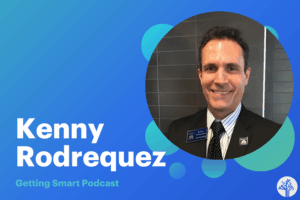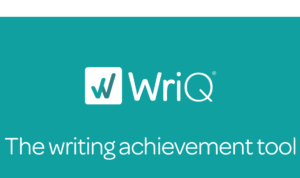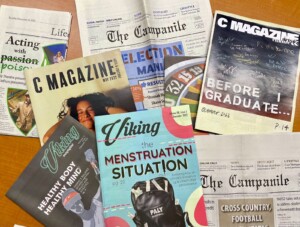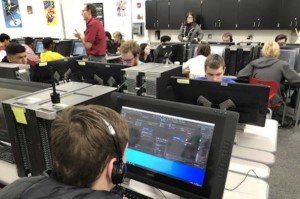Teaching Authentic Writing in a Socially Mediated World
I need to confess. As an English/Language Arts teacher with nearly three decades of experience teaching writing in her professional backpack, I am supposed to know what I am doing. But the radical changes in the way we communicate in contemporary society have led me to dive deep into an existential crisis.
What I Know and What I Don’t Know
 I know that a focus on building skills to communicate effectively in our media-driven, socially-networked world is more essential than ever. I know that harnessing the power of language (and images) to persuade and convince others requires a kind of mastery that nearly every member of society will need to access on a regular basis. I know the five-paragraph essay is dead – and should have been buried a long time ago – because it is a meaningless, formulaic construct. I know that asking students to write formal literary analyses has no real application for the majority of our students, who will not ever need to deconstruct a poem or discuss a story’s narrative structure in their professional lives. Yet these assignments are the stuff of my livelihood and profession, and I am struggling with what to do instead.
I know that a focus on building skills to communicate effectively in our media-driven, socially-networked world is more essential than ever. I know that harnessing the power of language (and images) to persuade and convince others requires a kind of mastery that nearly every member of society will need to access on a regular basis. I know the five-paragraph essay is dead – and should have been buried a long time ago – because it is a meaningless, formulaic construct. I know that asking students to write formal literary analyses has no real application for the majority of our students, who will not ever need to deconstruct a poem or discuss a story’s narrative structure in their professional lives. Yet these assignments are the stuff of my livelihood and profession, and I am struggling with what to do instead.
I should say, actually, that the problem is that I don’t know where to start. You see, I’ve completely bought into the idea that what we teach our students should be authentic, that is, tangible and real in ways that are meaningful and purposeful for our students. If I am to teach my students to become masters of their own self-expression through writing, my work should be delivered in terms of teaching them the actual forms and contexts that they encounter – and will encounter – throughout their lives, right?
What about the Common Core State Standards?
As I understand them, the Common Core standards still generally address writing in very traditional ways: as exposition, as narrative, and as analysis. These categories, while useful for looking at what writing can do (describe or explain, tell a story, convey complex thought), also encourage English teachers everywhere to continue to teach writing in the same old, inauthentic ways: tell a story about an embarrassing moment, describe the feelings the poem evokes for you, analyze the way the author conveys a theme. I’m not saying these ways of approaching English and Language Arts aren’t useful. They just don’t resonate for me or my students in today’s world.
My List of Contemporary Writing Activities
A recent conversation at SocialEdCon/ISTE Unplugged about online writing (let’s face it, most of the writing our students will do will be online in one format or another) led me to start the following list of contemporary forms of writing we need to address with our students. How such writing is made authentic depends on the context of how it is introduced in each learning environment, and, of course, this is where things get tricky. Tricky or not, here is my tentative list:
- Text messages to friends vs. text messages to colleagues
- Captions for photos that convey important and relevant information
- Questions that probe and dig for what matters
- Status updates that share a mood or point of view with a particular audience
- Comments on blogs and other interactive sites that continue the conversation
- Reviews of videos, music, products or services that argue a point with convincing detail
- Email that expresses an appropriate tone, conveys information succinctly, and invites further discussion or commentary
- Collaborative documentation (Google docs, wikis, etc.) that goes beyond divvying up and delegating sections to become, instead, actual co-construction
- Elegant tweets that add value and share perspective in a community of learners
- Blogs (in all their multitudinous forms) that allow ideas and information to percolate over time
- Citizen journalism that bears witness to the news of the day
- Storyboards and scripts that lay out way all the elements of how a video or audio will unfold
- Proposals to make, do, or change something
- Process analyses that examine the way things work
- Syntheses that draw together and make meaning of complex, disparate resources and multiple media; and
- Reflections that share transparently and probe thoughtfully.

Note that the Common Core emphasis on traditional rhetorical modes can be employed in many of these arenas. Text messages are essentially a kind of dialogue, and a tweet can certainly tell a story in 140 characters. Reviews and proposals are analytical arguments of a sort. Captions and status updates can describe; a process analysis explains in careful detail. Many of these forms use multiple ways of writing at once (reflection, for example), and some, like synthesis, invoke complex ways of organizing and thinking that are often overlooked in school. Finally, all of these forms of writing should incorporate visual elements as well as language. Drawings or sketches, screen shots, info-graphics, photographs, video – these things are just as important as the written word in conveying what we need to say today.
A Conundrum and a Sign of Hope
The forms in which our students write day-to-day give us a starting place for addressing authenticity in the English/Language Arts classroom. But they also leave out some of the artfulness of language I would mourn the loss of. So, I am still left pondering a conundrum: how can we teaching writing authentically and celebrate its power to move an audience, to invoke beauty, and make music? I find myself asking, Where is the place for poetry in the contemporary, digitized, socially mediated world?
Yet, attending a second day of ISTE Unplugged introduced me to the Global Education Summit, where I found some hope. Summit host Lucy Gray invited Rob Sbaglia of the Castlemaine North Primary School in Victoria, Australia to Skype into the conference. Rob described how he created an international Writer’s Club where students are empowered to write and connect in truly authentic ways with a global audience of readers. The keys to his success are simplicity of design, adaptability to different disciplines and age groupings, and the students’ freedom to pursue individual interests.
Also at the Global Education Summit, Jennifer Klein spoke about her work connecting students from around the world using poetry and art as a means to create dialogue. Embedding her work with students in the Taking IT Global network, she asked students to share their writing, artwork, and photography as a means of creating empathy and understanding of multiple perspectives about international conflicts. At one point, she described a teenager who articulated her own transformation from someone who looked only inside herself to someone who looked at the whole world. For a teacher like me, this was powerful inspiration.
Confessed and absolved, now I’m renewed and ready to change direction and start again.







Angela K
Thanks for your article! I am in a place close to yours, I want to find authentic writing for my students not just writing for the sake of writing. I am a special education teacher and I am going to try to have my students blog and comment on each other's blogs. I am thinking about having it be a way to talk about what we thought about stories. I like your idea of writing captions for pictures! This is very real life as all my students at on Facebook and say that they post pictures. How do they give information relative to the picture and not just describe the picture.
Replies
Tom Vander Ark
Thanks Angela. Love the idea of asking students to blog and comment on other blogs.
Anne Marie
While I agree that students need practice in writing more purposeful pieces that expand beyond the five paragraph essay, suggesting that the five paragraph essay is dead because students don't like to write in that format discredits a crucial process in learning to compose a cogent thought or thesis and then synthesize details to establish a logical progression of examples that further develop, in depth, the topic or question at hand. Tossing aside this practice is akin to tossing aside the fundamentals of physics while trying to design and construct a livable perhaps even innovative house. The five paragraph essay is not glamourous or entertaining but a much needed step in teaching students how to think and write cogent, compelling pieces for authentic purposes. When reading this blog, it seems that the term "authentic" suggests quick, unrefined, reactionary writing to solicit unearned praise from other unskilled or inexperienced "writers." I saw this when I checked out Rob Sbaglia's international writer's club. One example of fiction writing I read lacked, among other things, any character development or sentence variety. Ironically it read like he wrote it in response to an assigned prompt from a teacher. Now given that he was only ten, he certainly hasn't had much experience or training in writing fiction. But what I find upsetting is that the responses to his writing provided trite comments from others his age and no thoughtful input about his characters or their motives --what I categorize as authentic feedback--that would help him develop as a writer and thinker. So much interaction and communication today lacks depth and substance that we as teachers should promote more writing that requires reflection on one's own knowledge (or lack thereof) and investigation of the why's. The "authentic" in writing should be found in examining one's purpose, audience, and quality of message. Case in point: Even the previous comment about how to write an engaging, relevant caption as opposed to merely identifying or summarizing the contents of the photo requires thought, reflection, and understanding of the context. But one must also recognize that most Facebook messaging is not intended for wide critical or critically-thinking audiences, thus the writing is largely perfunctory and loaded with inside jokes. Also the photos are largely of people with arms around each other at the latest concert or of some sunset.
Emily Neal
Thank you for this wonderful article about addressing the needs of students in a relevant and authentic way. As teaching professionals we must change how we lead our students to strengthen their communication skills in such a way that they will experience joy, inspiration, and insight.
davidscottcampbell67
Thanks for your thoughts! Your shared internal dialogue and debate reflects the struggle that many educators experience (and should feel) as it seems we are straddling two eras of writing: writing for writing’s sake and writing for the individual’s sake.
I find much of the “authentic” writing to which you refer to be rather self-focused — it’s for the writer’s benefit. It seems like it’s for others (e.g. designed to create an impact on an audience through a blog or post, or uses web-based #irony) but really it’s designed to feed the “author” through the response of others (e.g. the reply to a post, the friending on FB, the acknowledgement that you somehow exist in cyberspace). Shouldn’t a part of writing be for the craft of writing itself? Isn’t there a place anymore in writing for skill or flair that contributes to the art of writing itself?
I’m not Japanese, but I understand there are a few alphabets in the Japanese language (I think 3) which have different structures and uses. You will see one, more simple, form on labels on packaging labels in supermarkets, while another writing form appears in letter writing. This “higher” form uses an alphabet that has more depth, and can be used to convey thoughts differently than the “lower” alphabet. Both of these Japanese alphabets are used and are needed, yet they have different purposes. My point: I wonder if the authentic writing you refer to is similar to the lower Japanese alphabet: needed for utility in the give and take of rapid information flow, but lacking the art of writing, skill development and expression found in the higher forms of writing (literacy response, expository essays, poetry, etc.)?
Your definition of “authentic” seems to refer to the writing forms your students use: “the actual forms and contexts that they encounter – and will encounter – throughout their lives”. Isn’t part of our role as teachers to take students to where they don’t live and to what they don’t encounter: new thoughts, new processes, higher thinking, an unimagined body of knowledge? Where students don’t usually live, what they usually don’t use — these are writing skills and forms of the “higher alphabet.”
Let’s not displace one alphabet for another in the name of “authentic” writing. It’s all writing, and all needed, but let’s not sacrifice one on the altar of the other. Meet students where they are, but lead them forward to the higher alphabet of thought, process and skills.
Susan Davis
Thank you, Angela, Tom, Ann Marie, and Emily, for your thoughtful responses.
While I have concentrated on certain contemporary "forms" of writing here that I believe are likely to be more authentic for most students today, the context and purpose in which the student is writing remain key. Students certainly need their teachers' guidance in learning how to craft a strong argument, no matter if it is within a series of comments such as we are using here or providing a thoughtful caption to add punch to a photograph.
Five-paragraph essays, as I have come to view them, are largely artificial constructs that are used to teach a kind of formulaic writing that has a standard structure of a beginning, middle, and end, and that has three illustrative points. (Why three, I've always wondered, but so it goes.) That structure can be used to make an effective argument, but it has no real application in life that I know of.
Likewise, blogging just for the sake of blogging doesn't necessarily yield the kind of rich writing and deep thinking I'm after either. But exploring what blogs can do -- as a form that develops through time and with conversations embedded in them like this one -- is something teachers can undertake with their students if it opens up an authentic avenue of communication.
Wouldn't it be better to explore with our students the power of a descriptive status update, the arc of a story, the ways to provide useful feedback, or the clever retort that might serve one well in a text or tweet?
As Ann Marie indicates, the "quality of message" is what we need to seek out. If we can do that in an authentic context, all the better.
Susan Davis
David,
Let me clarify what I am thinking when I use the term authentic.
I am really trying to capture something about the experience of writing. It is something that captures a sense of purpose for the writing -- other than writing in response to something a teacher has constructed for the sake of instruction. The writing within a traditional English class can certainly be brilliant or vapid, just as a Facebook status post can be.
I guess I am struggling to find forms -- perhaps venues is a better word -- for students to try out their ideas, with their teachers' guidance, as a way of creating meaning to share with others.
Your comments about the "self-focus" remind me of one of my favorite essays, "Why I Write" by Joan Didion. She asserts that the essay is always about the the writer calling attention to him or herself.
Interestingly, the new ways of writing we are discussing here actually force us out of ourselves in order to engage with a wider audience in powerful ways.
What comes of that... well, that depends on the writer's commitment to the craft, doesn't it?
Thanks to everyone for pushing my thinking!
Rhonda
Great article - you gave me many things to think about! Thank you for mentioning Joan Didion's "Why I Write." I had not read it, so thanks to our new world, I googled and enjoyed the essay.
Chaya Friedmann
The error is in viewing the structure of the 5-paragraph essay as the end-all of the writing lesson. The formula you deride is the guide that can help students write meaningful, authentic CONTENT in a format that communicates well to others. It does so because it is a contract between the author and the reader, helping the reader find the information (authentic opinion, defense, feelings, context, etc.) in expected places so that communication is successful. Authentic self-expression has its place, as noted. However, as teachers we must teach our students the skill and art of communicating well in all contexts, using a format whose conventions enable shared communication (similar to using oral language that all understand). Eliminating the 5-paragraph essay is a huge disservice to students who already believe that writing is all about self-expression in any form. Focusing on the list you describe, at the cost of the 5-paragraph essay, simply reinforces that self-expression which students can already do pretty well but which doesn't help them communicate well.
Rebecca Buzzell
I disagree that teaching kids to write a 5 paragraph essay is dead. If you think about good communication - whether oral or written - first of all, you need to be able to get your point across and be able to back up your statement with details. Students can already tweet, blog and chat - they need to learn to focus on a complete thought and to back up what they say with details. The new Common Core Standards focus more on formal writing, not less. While the 5 paragraph essay may not be popular with kids, it does give them a starting point for organizing their writing and supporting their statements with details. My students saved their writing for the year - this June, they looked back through their work and wrote a reflection on what they had learned and how their writing had improved. All students noted improvements - their writing was clearer and easier to understand, less wordy, more interesting / better word choice and many noted that they were much better at organizer their information. Paragraphs and essays are not dead - they serve an important role and should be continue to be a part of writing.
Nelda
Wow! This dialogue strikes some important chords with me. I teach language arts, and in an effort to strengthen my students' writing skills, I transitioned to the use of a blog to capture more " authentic" responses to literature. I hoped to tap into students' love of online/ social media discourse to discover that they would invest more words, ideas there than on paper in traditional written assignments. Yes, everyone turned in a response, but the quality and craftsmanship, care and attention to their word choices and idea presentation was not better. They were always more succinct, maybe " edgier" than handwritten responses, but something was lost in our failure to hold a peer's paper ( with a post-it sticky or margin notes) to offer feedback, I think. We didn't focus enough on revision like with essays. Perhaps that's my fault; I was intent on addressing process and not product. I've got to find a balance this year. Thanks for the insight. Nice to know I'm not alone!
Susan Davis
The debate here is exactly what needs to happen in schools everywhere. What are the truly essential elements of writing that need to be taught? How to manipulate structure is one. How to craft a lovely sentence is another. How to capture detail, how to make an argument... You are all right to mention that the form does not make the writing work. It is the experience of addressing all of these important elements of communication within forms or venues that have relevance that I think is important. I hope my students will then figure out how to eschew formulaic writing and choose the right words for the right impact for the purpose at hand.
Peter
In my opinion, the idea that we should prepare students to write effective photo captions, text messages, and status updates as the core focus of our English curriculum is hard to swallow.
At the end of the day, our charge as teachers is to help students learn to communicate effectively. That means we need to teach students how to analyze sources, synthesize information, and build positions / arguments. That's why we teach the five paragraph essay. It's taught for a reason.
We ask students to analyze literature because they're using the same tools that will allow them to eventually analyze a newspaper article, report, or Powerpoint slidedeck in their professional lives. We also read and discuss literature because it gives sorely-needed perspective.
Just my two cents.
Masters Student
I am currently taking a masters course in action research, and authentic writing is my research topic. This hits on many of the ideas and topics I've been researching, as well as giving me some more ideas.
As for the 5-paragraph essay- I see both sides. There is value in understanding such a formula because students will will need to know how to write collegiate papers, professional documents, etc.; however, generally life is not a 5-paragraph kind of thing. There are many other forms of effective writing that are more relevant to students (and people in general) today. I think the trick here is not negating the "dead" formulaic 5-paragraph essay, but somehow incorporating such formulas into "authentic" writing experiences. For example, students could research a career they are interested in. While using effective communication (and a 5 paragraph essay format), they could still write for a purpose. It is good to know about different career choices. To give more purpose to their writing, their research could be published for classmates (I'm thinking high school) to learn about different career paths.
SA
I agree with previous posts commenting on the value of exercises such as the "five-paragraph essay". These exercises helped me learn to organize thoughts at an early stage of academic development. Elementary and secondary school years go so quickly and they are an excellent context for establishing reliable formulaic tactics of communication. It would be pointless to expect people to only ever use these methods. But they can be integrated in purposeful ways by well-intentioned teachers.
JCC
Although I certainly concur with your comment about the formulaic aspect of the five-paragraph essay, I continue to see value in literary analysis. It is the process of critical thinking which literary analysis challenges. This aspect (critical thinking) should be the concentration of our creative approach to reevaluating the authenticity of writing assignments. Literature is a valuable vehicle which precipitates reaction from students when they become increasingly interactive with their texts, whether in terms of annotation, discussion, or analysis.
Lindsay Favela
First of all I want to say great blog! I had a quick question in which I'd like to ask if you don't mind. I was curious to know how you center yourself and clear your thoughts prior to writing. I've had a tough time clearing my mind in getting my ideas out there. I truly do take pleasure in writing however it just seems like the first 10 to 15 minutes are lost just trying to figure out how to begin. Any recommendations or hints? Appreciate it!
Lynn
Susan,
Your blog was so refreshing to read. I help in-service teachers unpack the learning standards their schools have adopted and weave them into their authentic teaching ideas. I don't support or promote any specific set of standards because I think schools should adopt or write their own to represent outcomes for students based on their philosophical or curriculum framework. Teachers often bristle when presented with an adopted set of standards and express the need to throw out everything they have ever done. I appreciate how you very accurately presented that Common Core is traditional and in many cases too specific in content but went on to say that it IS possible to weave them into authentic and 21st century writing skills. Thank you!
Mayra Rodriguez Ruiz
Thank you for this great article, Susan. I totally agree with the idea that nowadays students should be asked to write based on authentic situations.